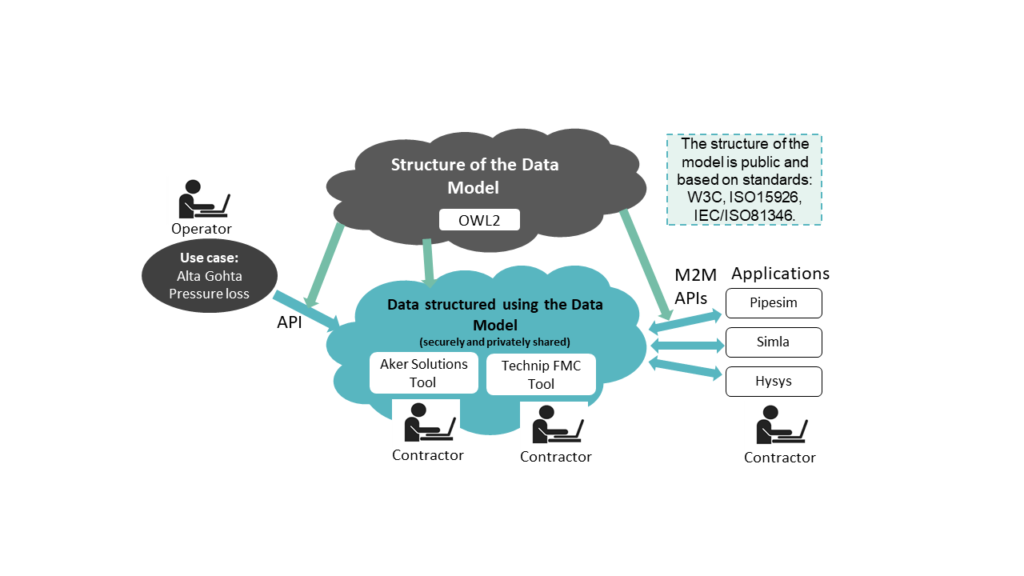The Digital Design Basis Project
SIRIUS has been working since 2017 to support the findings of the KONKRAFT report on competitiveness on the Norwegian continental shelf. This meant that SIRIUS workers have been part of a working group that has discussed how semantic technology could be used to implement a digital design basis for early-phase field development. Here an oil company prepares an information package that describes the natural conditions, requirements and scope for a field. This package is sent to suppliers, who then work with the oil company to investigate concepts and prepare a costed conceptual design. This design is used to decide whether the project will proceed or not. The working group contained representatives of Aker Solutions, TechnipFMC, Aibel, Equinor, Lundin Energy and AkerBP. This resulted in a project that started in 2020 to build a prototype data model and demonstrate its use for sharing the design basis. The partners in this project were Lundin, AkerBP, TechnipFMC, Aker Solutions and Aibel. During the project, Aker Solution’s information technology organization was reorganized. The project then involved participants from Aize and Cognite.
KonKraft aims to develop national strategies for the petroleum sector and has an industry-wide mandate. The recommendations in the recent report spring out of a process where key stakeholders in the oil and gas industry were consulted. Several SIRIUS partners contributed to the KonKraft work and SIRIUS’ leadership engaged in two meetings with the KonKraft working group. Given the current focus on digitalization there is every reason to believe that the KonKraft report will be carefully read in the industry.
The Digital Design Basis models and demonstration application are available through SIRIUS. Pleases send a request to access by filling out the following form: https://nettskjema.no/a/ddb
The aim of the Digital Design Basis project was to build a common data model that organizes the data that an operator shares with their suppliers in early-phase development. Instead of sending documents and spreadsheets, the operating company can prepare a set of data that uses the common model. This is then sent to or shared with the supplier. The data will be imported into the suppliers’ own engineering tools and simulation programs.
The concept is shown in the following figure. The data model is written using the OWL2 standard for semantic modelling and provides a framework into which the operator can place their data. The modelling also uses the new Part 14 of the ISO15926 standard. The model describes the main systems in the proposed concept, using the ISO/IEC81346 system breakdown proposed in READI project. This breakdown enables the various requirements and pieces of information in a design basis document to be linked to systems in the concept.
The project has built the first version of the common data model and used it to demonstrate a flow of data about Lundin’s Alta Gotha field to Aker Solutions and TechnipFMC. Each of the suppliers were able to load this data into their internal engineering tool and use it to set up a calculation of pipeline pressure loss.
The work is organized as a SIRIUS innovation project. The project partners wanted a simple, easy-to-negotiate project model with an agreed management of intellectual property. SIRIUS’ contract provided just such a model.
Results from this phase are promising. The model structure is built on existing industry standards and can be a starting point for standardizing data transmission at later phases of the development. Our ambition for further work is to deepen the model so that it supports FEED studies on the chosen concepts. In this way, we will be able to track requirements and design decisions from early phase, through FEED and engineering and eventually into operations. Here we will be able to exploit synergies with other projects in the Digital Twins and Digital Field Development demonstration, such as PeTWIN and DSYNE.
However, just as a tool for early phase development, the DDB offers savings in labour and improvements in the quality of data. The development uses SIRIUS skills and technology, such as the OTTR ontology templates to simplify the development of the model. The model is open sourced and will be maintained and made available through the SIRIUS Laboratory.
This project has validated the SIRIUS innovation model. The centre has provided a neutral place for collaboration between companies across the business ecosystems. Our contract models provided a quick and effective way of setting up formal collaboration. Finally, our tools and methods have been used in the work and the project has provided feedback to the SIRIUS laboratory.



